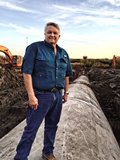Improved maintenance helps deliver irrigation water to South Texas
Spring 2016
The challenge is keeping the canals, ditches and reservoirs clean so the water flows throughout the lower Rio Grande Valley. The addition of Doosan excavators and a wheel loader has made that much less of a problem.
The Delta Lake Irrigation District in South Texas is the largest of the 26 irrigation districts in the valley. Although it’s called a valley, the area is actually a delta that lies along the northern bank of the Rio Grande River that separates Texas from Mexico.
The delta is a prime farm area. The district uses a series of canals, ditches and pipelines to deliver the water needed to irrigate 83,000 acres of agricultural land. Water for agricultural use is diverted 320 days a year because much of the land is double-cropped.
When Troy Allen, general manager, arrived at Delta Lake in 2003, maintenance of ditches and canals had been neglected for about six years. Some of the canals had 4 feet of silt in them, reducing water flow by two-thirds. The main cleaning tool, a dragline, was broken.
“The first year I was here, we purchased a Doosan excavator to clean out the ditches and canals,” Allen says. “We were so far behind that we worked the machine 12 hours a day, five days a week. Within the first five years, we racked up 10,000 hours on the excavator and, as a result, the diverted water routes were in much better shape.”
Cleaning ditches, canals
Eventually, Allen was able to purchase more excavators and a wheel loader. He had such good luck with the first Doosan excavator that he returned to the local dealer. With 165 miles of drainage ditches, 42 miles of earthen canals and three reservoirs to clean, the Doosan excavators stay busy. “The ditches and canals have to be cleaned every three or four years,” Allen says. “Our soil is mostly sandy loam, so it regularly washes into the waterways. Silt builds up, especially after a storm.”The earthen canals are 40 to 120 feet wide, and ditches range from 20 to 120 feet wide.
“Initially, we had to take out trees and brush from several of our waterways,” Allen says. “We used the standard-reach excavator to remove that growth and followed with a super-long-reach machine to work to the center of the canals and ditches. Now, we mostly use the super-long-reach excavators to handle these projects.
“Our operators do a good job of spreading out the dirt. It’s relatively easy to remove and relocate to areas where banks have to be raised,” Allen says. “We use our Doosan wheel loader to load trucks for transport to other locations.”
The district’s three reservoirs total approximately 2,240 surface acres — that’s more than 10 miles of surrounding banks that have to be cleaned of silt every three years. That work is handled by the excavators, too.
“Today we are getting so much more done that we receive compliments all the time. Everything is so much better when you have the right equipment.”
 English
English



